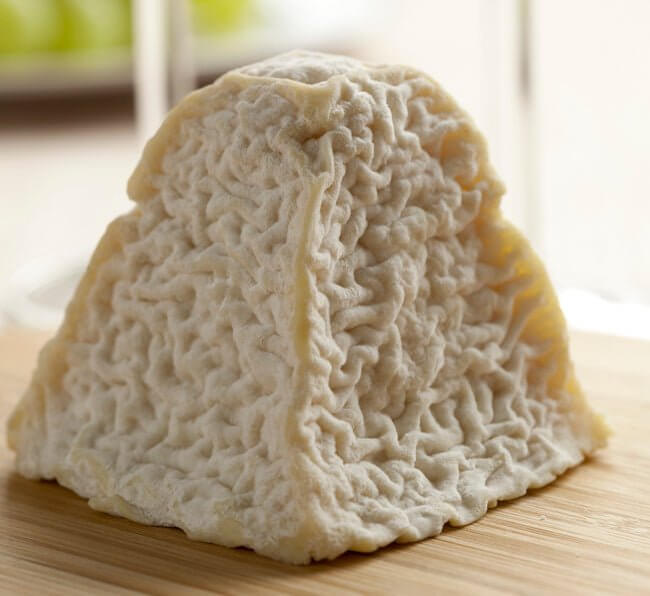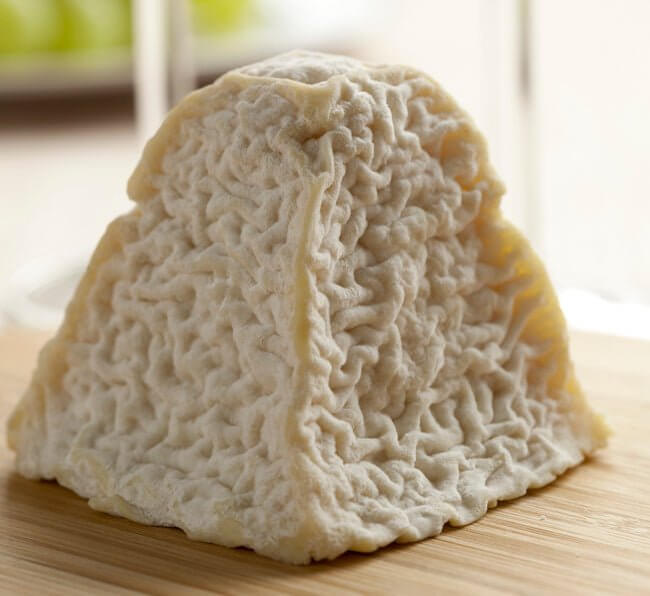
Pouligny St Pierre Cheese Making Recipe
-
Yield
2 Pounds
-
Aging Time
~1 Month
-
Skill Level
Intermediate
-
Author
Jim Wallace

Pouligny St Pierre Cheese Making Recipe Info
About Pouligny St Pierre
How to Make Pouligny St Pierre
History & Legends
Styles & Aging
Ingredients
Total price for selected items: Total price:
Instructions
The Essentials of Making Pouligny St Pierre
- Pouligny St Pierre is essentially a lactic cheese, meaning the curd forms primarily from lactose conversion and acid production. This cheese needs a long coagulation of 10-12 hours before being ladled to forms where it will drain for 10-12.
- Once the curd forms it doesn't need to be cut much, instead the curds are simply ladled into forms. Try to break the curd as little as possible when transfering them into forms.
- Frms in the shape of inverted pyramids with flat tops are used. This is possiabably because slanted sides encourage more draining than straight sides, since gravity helps to release the whey and directing it out of the form rather than down through the curds can be faster.
- Once removed from the forms, the cheese is inverted onto their wider bases. Natural yeast and added Geotrichum mold will begin to form on the surface. Traditionally a Penicillium mold (P.album) that turned blue grey when developed naturally found its way onto this cheese. Today this mold has been isolated and can be added to the milk and/or sprayed on the surface.
-

Heat & Acidify Milk
Begin by heating the milk to 72F. Since I am not cutting and stirring much or heating the curds before molding I keep things simple. I do this by placing the milk (still in its travel container since it has a very wide opening for ladling) in a large pot of very warm water. The milk comes in at 36F and my water is 120F, so that in less than an hour I am ready to go with the milk at the perfect temp.
Once the milk is at 72F the culture can be added. To prevent the powder from caking and sinking in clumps sprinkle the powder over the surface of the milk and then allow about 2 minutes for the powder to re-hydrate before stirring it in. Let this rest quiet for about 1 hour while the culture begins to work.
-

Coagulate with Rennet
Now add about 4 drops of single strength liquid rennet. Remember this is a lactic cheese so very little rennet.
The milk now needs to sit quiet for 2-3 hours while the culture works and the rennet coagulates the curd. At this point you will find that the milk has begun to thicken (the initial flocculation). Continue to allow the milk to sit quiet for an additional 8-9 hours for a total of 9-11 hours from adding the rennet.
The curd is ready when it has shrunk away from the edges and perhaps cracked in places with about 1/2 or more of whey on the surface. The curd should taste quite tangy at this point.
During this long wait make sure you prepare your molds and transfer area by sanitizing everything.
-




Form Curds
When the curd is ready, there is actually no cutting, instead the curd is removed with a ladle and carefully placed into the molds to avoid breaking it. Fill the mold to the top and wait for settling before topping up, you may need to do this in a few cycles.
The filled molds should be allowed to drain for the next 10-12 hours (overnight) at a moderate room temperature (72F). The next morning should find that they have settled in the molds by about 25-30%.
Once the whey drainage has essentially stopped, they can be removed from their molds and inverted onto their broader bases for salting and drying.
Now having mentioned the shrinkage above, I had always wondered how they got the full mold height for the cheese in France at the end of draining until I visited a small operation in the area of production several years ago (see below for more on this).
I find this hard to do here so I am happy to make these to a bit smaller height format.
-

Salting
Once the whey stops dripping the cheese can be salted. At this point I measure the weight of the fresh cheese at about 3.2-3.5lbs from the 2 gallons of milk. I always salt by weight and use about 2% by weight of cheese as it comes from the mold. For this cheese it came to a bit over 1 ounce. I place the 1 oz. of salt in a shaker and evenly distributed this over the fresh forms. Allow these to rest while the salt dissolves and is absorbed into the cheese.
-




Aging
After the molds have been removed and the cheese salted, it is given 2-4 days of initial drying at a cool cave like temp of 52-56F but a drier 65-70% moisture.
You should then age it for about 14 days (same cave temp but increase moisture to 85%). At this point you should see a dry surface with a light white cover and perhaps some spots of blue may begin to develop.
Notice the typical reticulation developing on the surface. This is a typical effect of the geotrichum growth and some drying of the surface and is found to varying degrees on this style of cheese.
You can now move it to a refrigerator at 38-42F and wrap it at this point as well. After another 1-3 weeks the cheese will mature more and will be ready for the table.
I decided to wrap some of these and leave others unwrapped to see if it made a difference. I find the wrapped cheese developed a more homogeneous white surface based on geotrichum while the unwrapped cheese developed a colorful mantle with some blue (most likely a form of P.glaucum) that occurred naturally. They were both delicious.
Note the difference between the natural rustic looking cheese and the wrapped snow white cheese in the photos above.
Cheese Making Supplies
Related Products
You May Also Like


































